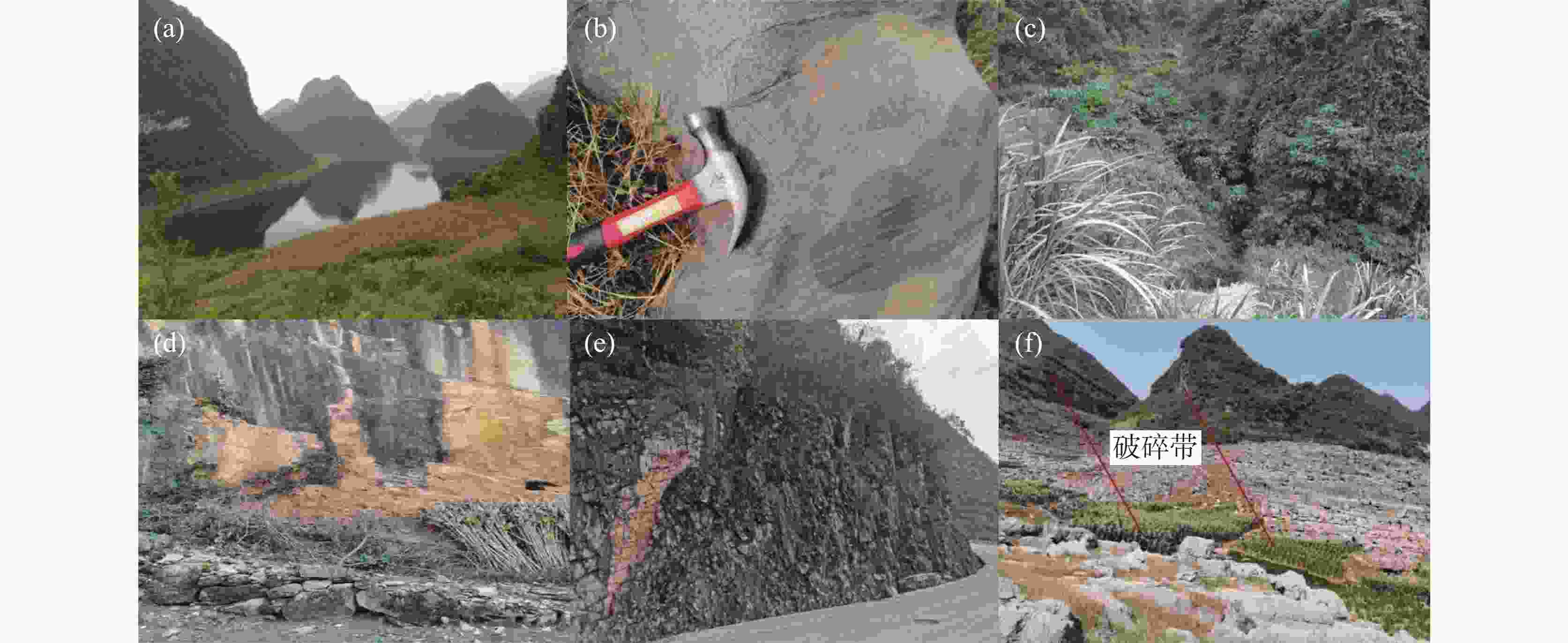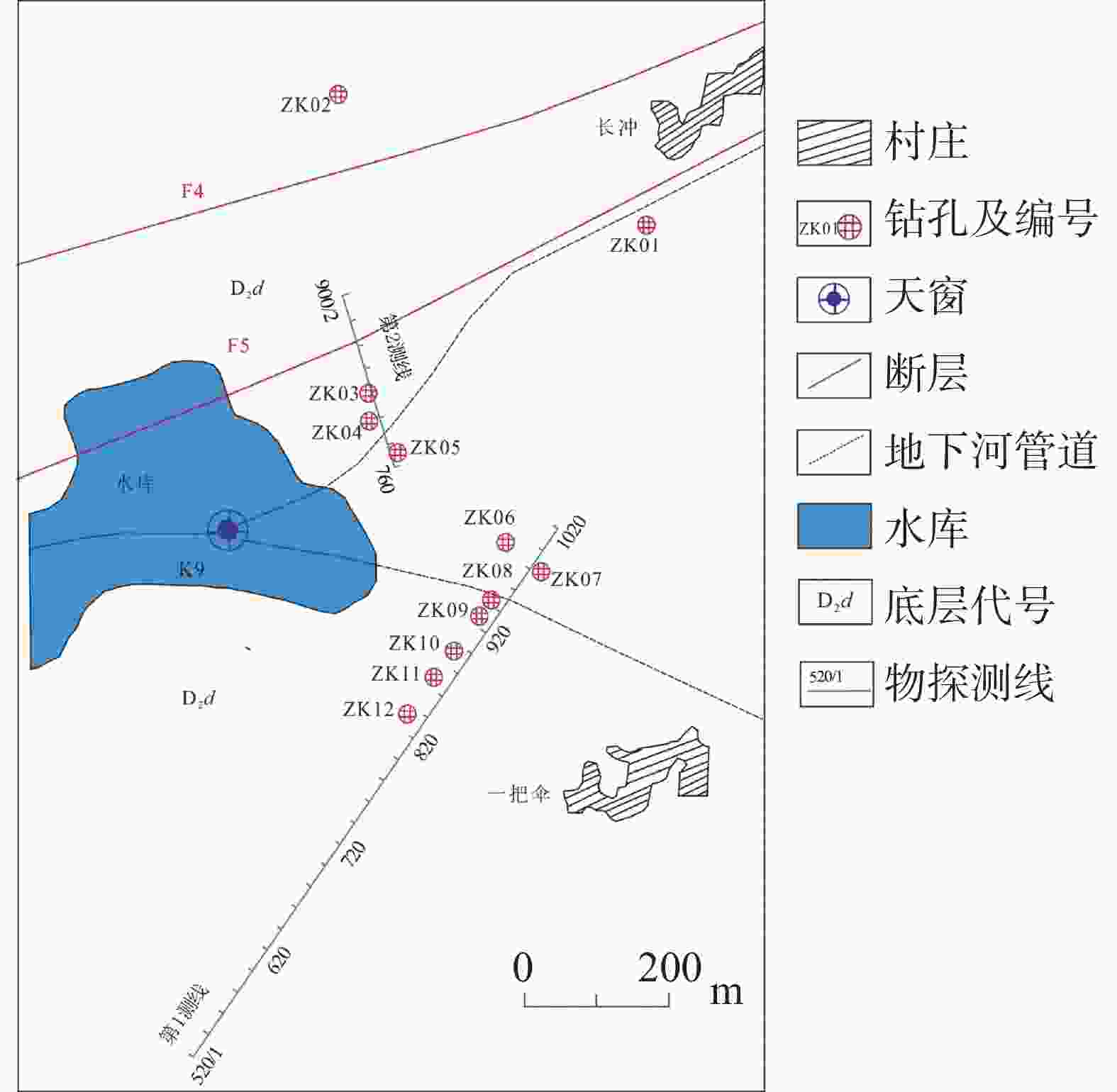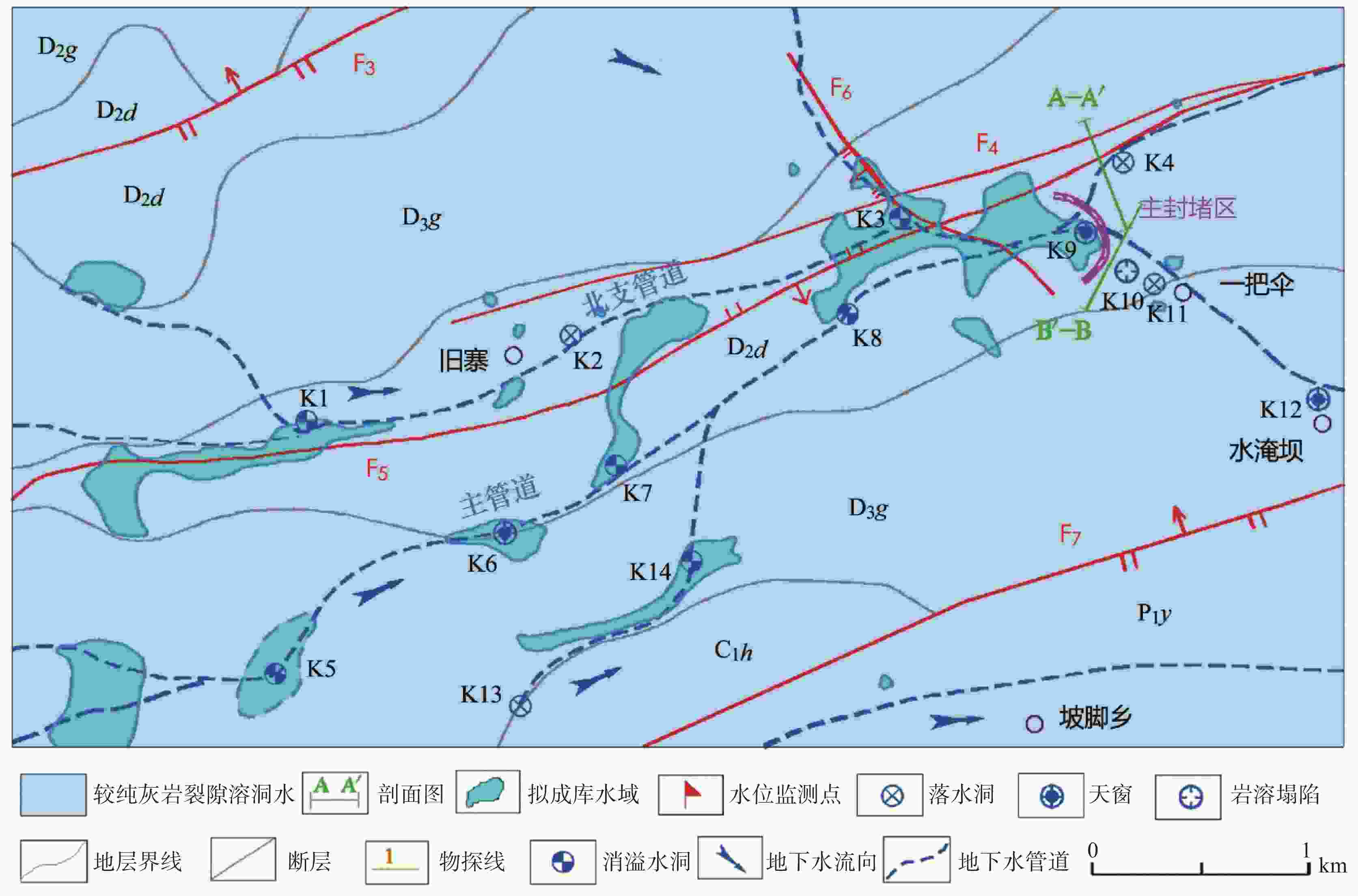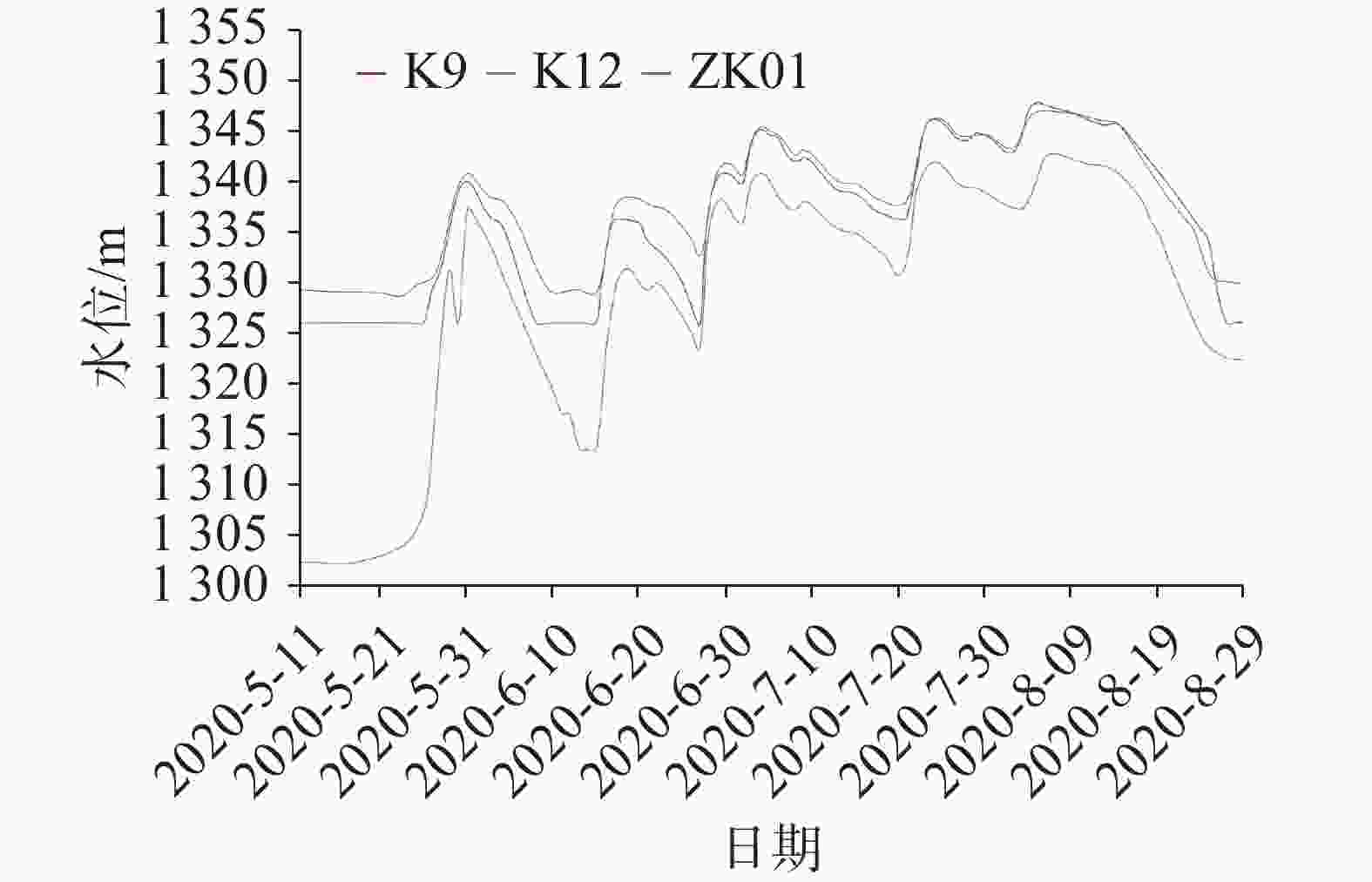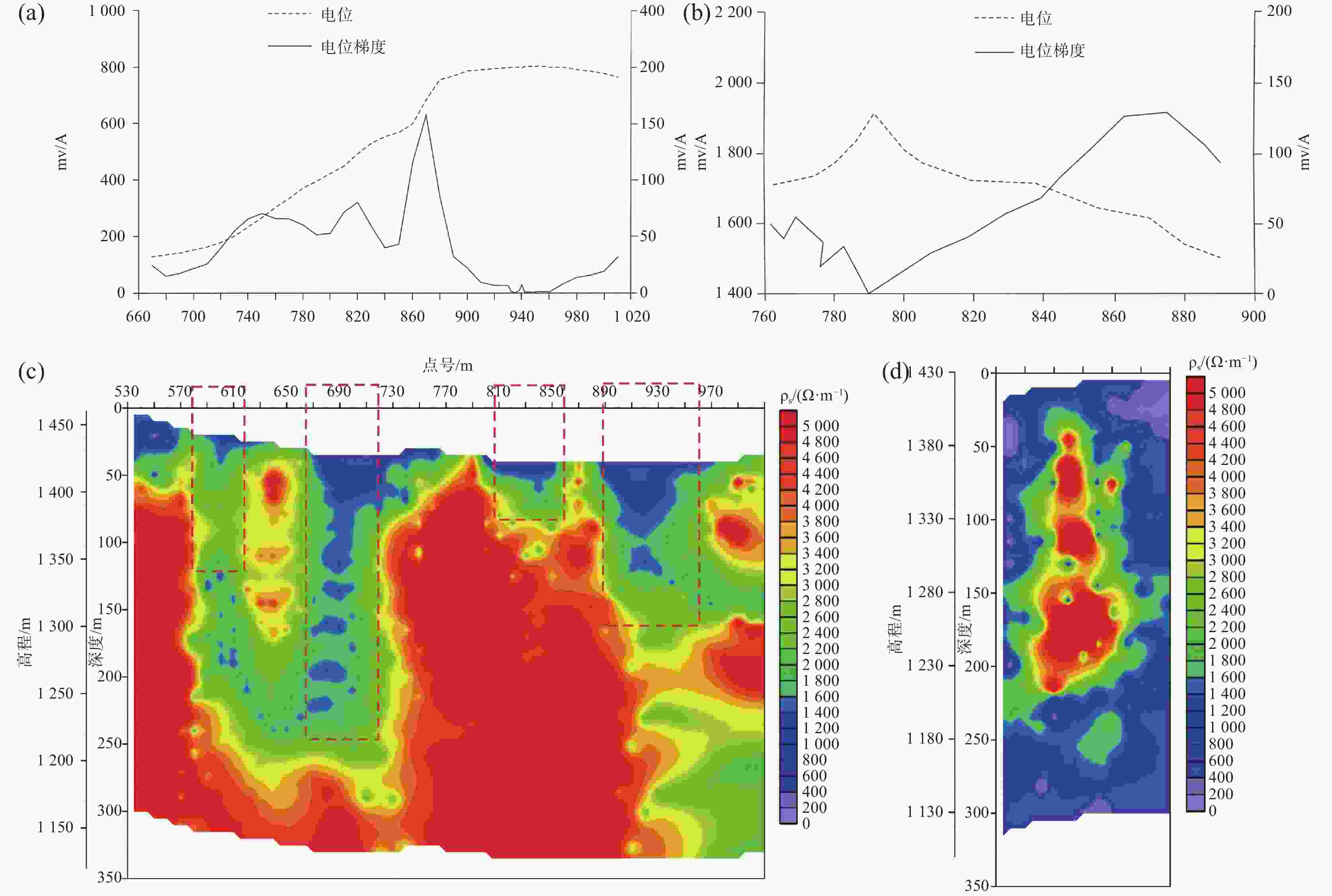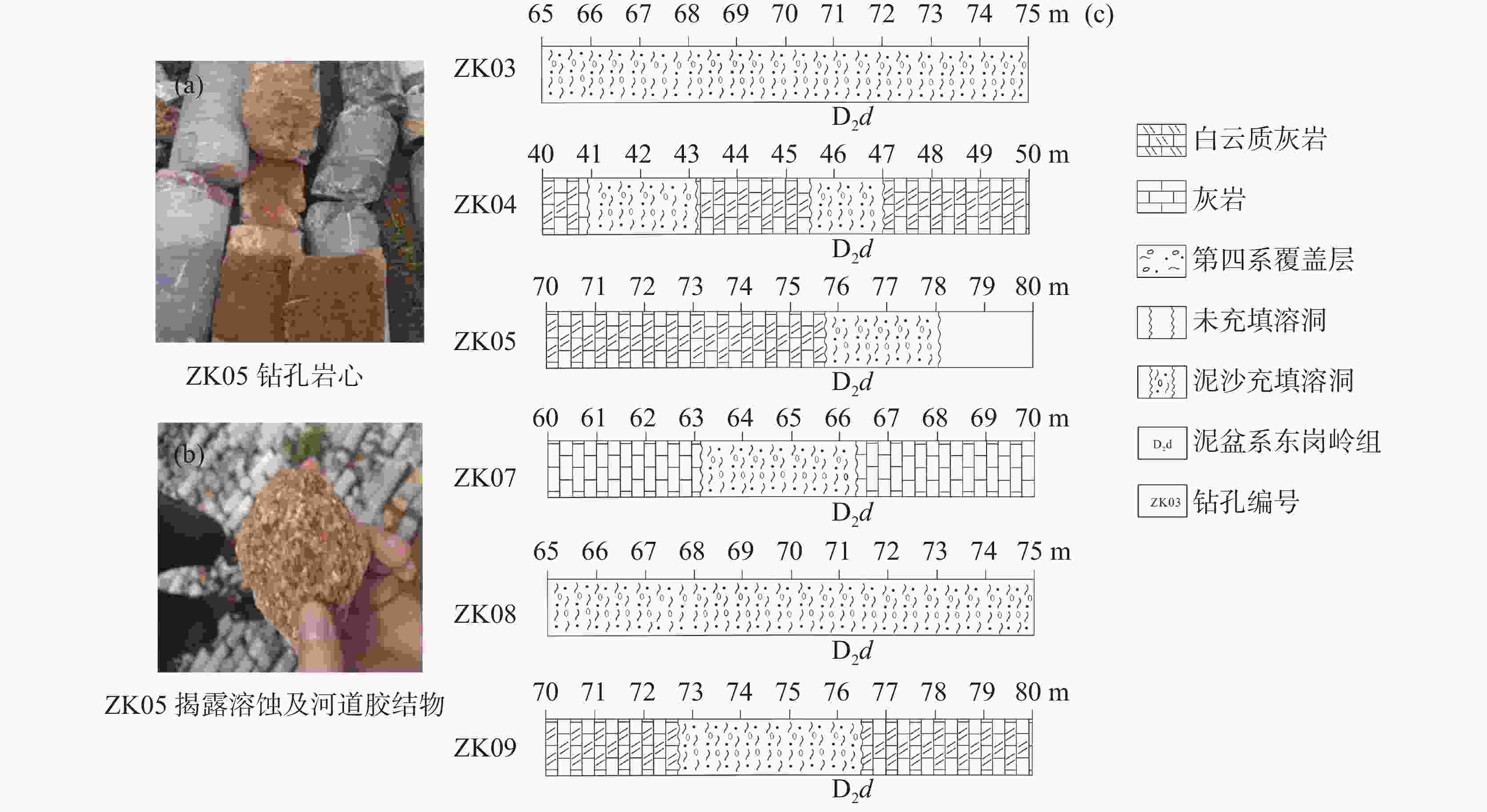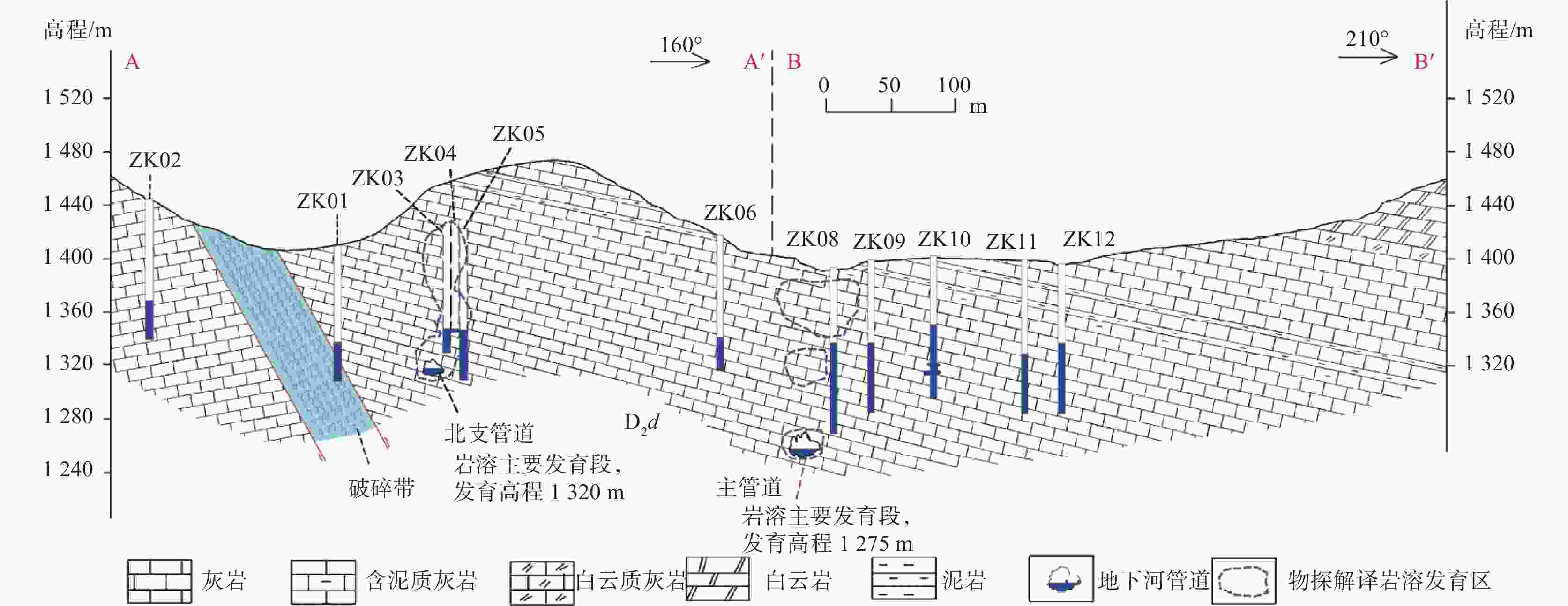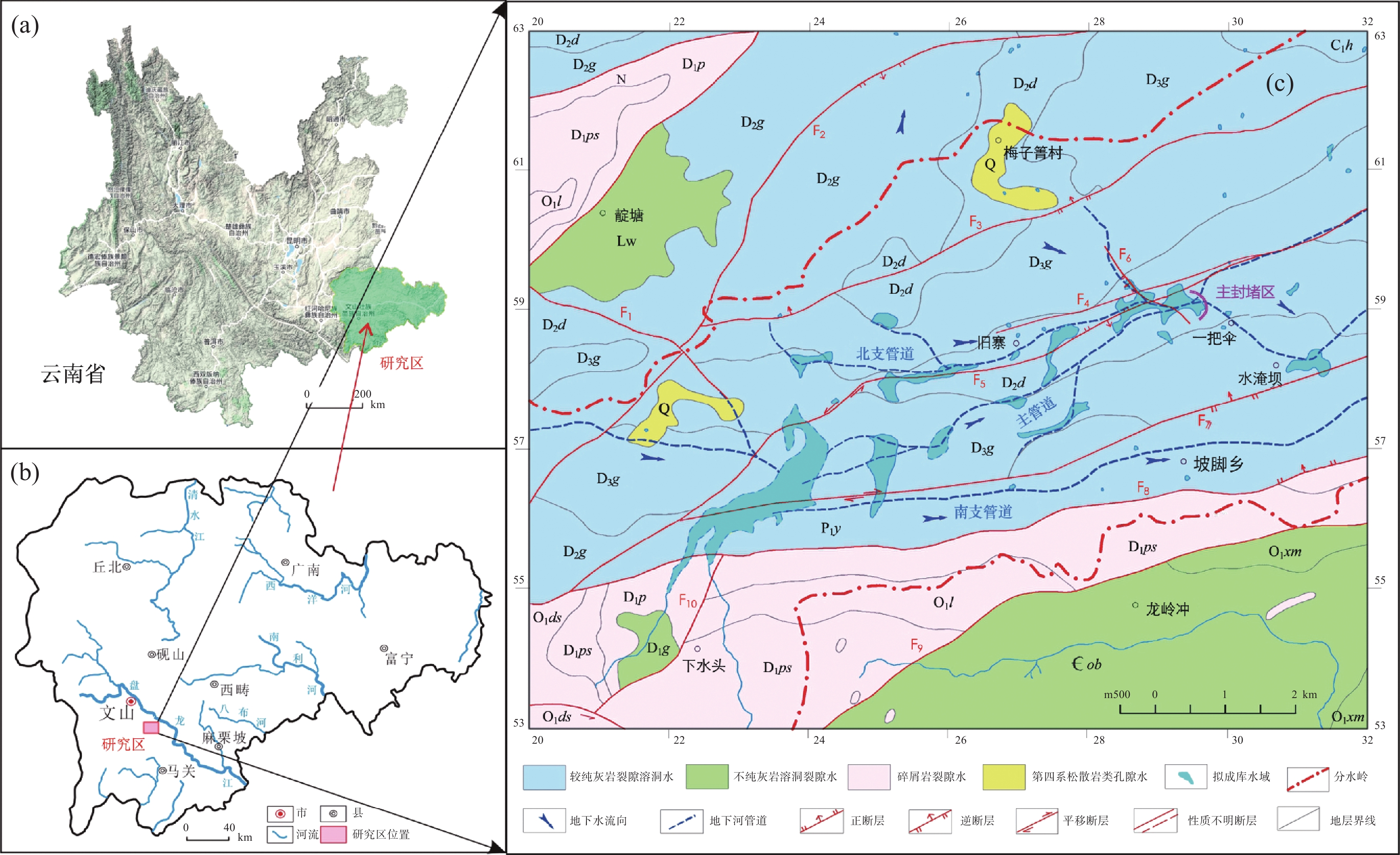Analysis of karst leakage conditions and pipeline characteristics in the main blocked area of Yibasan reservoir, Yunnan
-
摘要: 水库渗漏是岩溶地区兴建水利枢纽关键的病害问题之一,以一把伞水库主封堵区为例,水文地质调查、地下水位动态监测、地球物理探测和钻探相互验证,分析主封堵区水文地质条件,识别岩溶渗漏管道位置及发育特征。结果表明:主封堵区岩溶渗漏带发育于泥盆系东岗岭组(D2d)较纯碳酸盐岩,SW至NE向压扭性断层构成南北隔水边界,东西两侧为透水地层,上游地下河至主封堵区汇流后又迅速分为南东、北东支流。岩溶渗漏带包括主管道以及北支管道,渗漏管道发育位置受断层作用控制显著。研究揭示了岩溶渗漏的季节变化规律,提出了主管道与北支管道的渗漏条件,并分析了渗漏管道分布特征、规模及充填性质,为一把伞水库主封堵区渗漏防范提供科学依据,并为岩溶地区类似渗漏病害问题的治理提供借鉴意义。Abstract:
Reservoir leakage is a significant challenge in the construction of water conservancy projects in karst areas. Yibasan reservoir is a key water source project planned for Wenshan Prefecture in Yunnan Province. It is a storage reservoir composed of 11 surface seasonal karst lakes, underground river pipelines, karst caves and fissures. The proposed storage capacity is nearly 90 million m3. The main blocked area is planned to be built at the concentrated distribution line of large depressions. Many large depressions are located in the upper reaches, while the height differences in the lower reaches are relatively gentle, with an overall arc length of nearly 800 m. The project is planned to be constructed with the use curtain grouting, flood discharge tunnel and other methods, with a total storage capacity of 11,412,600 m3. The presence of leakage zones in the main blocked area and their characteristics are critical to the success of sealing process. Taking the main blocked area of Yibasan reservoir as an example, the hydrogeological survey, dynamic monitoring of groundwater levels, and geophysical exploration and drilling have been employed in conjunction to analyze the hydrogeological conditions in the main blocked area and to identify the location and development characteristics of karst leakage. The results show that the karst leakage zone in the main blocked area is developed in the pure carbonate rocks of the Devonian Donggangling Formation (D2d). The lithology consists of thick layers of silty crystalline limestone, dolomitic limestone interbedded with thin layers of marl, and muddy limestone. The south-north water boundary is formed by the SW to NE compression and torsional reverse fault, Water permeable strata are located on both sides of east and west. After the confluence of the upper reaches of the underground river to the main blocked area, the river rapidly divides into southeast and northeast tributaries. The F6 water-guiding fault in the direction of NW to SE crosses the main blocked area and opens the F4 and F5 fault planes. The width of the fault influence is 80 meters, which provides the structural conditions necessary for the formation of karst leakage zone. This karst leakage zone encompasses both the main pipeline and the north branch pipeline, with the development location of the leakage pipeline being significantly controlled by faulting. The study revealed the seasonal variation of karst leakage, proposed the leakage conditions of the main pipeline and the northern branch pipeline, and analyzed the distribution characteristics, scale and filling properties of the leakage pipeline. Through the analysis of groundwater level and monitoring of groundwater flow, it has been observed that when the groundwater level in the reservoir area exceeds 1,330 meters, leakage occurs from the main pipeline to the northern branch pipeline. In the dry season, groundwater is mostly discharged downstream through independent pipelines. In contrast, during the wet season, about 1/3 to 1/2 of groundwater is discharged into the northern branch. Hydrogeological analysis, monitoring of groundwater dynamics, and results of geophysical exploration and drilling show that the development scale of the leakage zone of the main pipeline is larger than that of the northern branch pipeline. The drilling results also show that filling or exposed karst caves can be seen on the surface of the drilled core near the main pipeline and the northern branch pipeline, and there is an obvious "blowing phenomenon" after the formation of holes. There is no sediment filling in the karst cave with the northern branch pipeline above 40 m; however, there is an increase in sediment filling in the karst cave below this depth. Similarly, there is no sediment filling in the karst cave with the main pipeline above 50 m, while there is a notable increase in sediment filling in the karst cave below this depth. This suggests that the development depth of the underground river is below 40 m, and the drilling results are consistent with the geophysical findings. The karst leakage zone of the main pipeline exhibits a large leakage scale, characterized by a development width of about 30 m, a depth of about 120 m, and an elevation of about 1,290 m. The development location is identified between 940 m and 960 m along the first survey line and at the ZK08 borehole. In contrast, the karst leakage zone of the northern branch pipeline is smaller in scale, with its development situated along the second survey line at 785 m to 795 m, as well as at ZK04 and ZK05 boreholes. This zone has a development width of about 10 m, a depth of about 100 m, and an elevation of about 1,320 m. This study establishes a scientific basis for leakage prevention in the main blocked area of Yibasan reservoir, and offers a reference for the treatment of similar leakage issues in karst areas. -
Key words:
- karst leakage /
- pipeline characteristics /
- geophysical exploration /
- fault structure /
- Yibasan reservoir
-
1 (a) 一把伞水库地貌特征,(b) 水库附近出露灰岩,(c) 水库附近落水洞,(d) F3沿线断层面紧闭, (e) F7断层沿线发育紧闭裂隙,(f) F5断层影响宽度达80 m
1. (a) geomorphic features of Yibasan reservoir, (b) exposed limestone near the reservoir, (c) sinkhole near the reservoir, (d) the tightly closed plane along the F3 fault; e. closed fissures developed along the F7 fault; f. 80-meter-wide influence of F5 fault
表 1 研究区地层岩性表
Table 1. Stratigraphic lithology in the study area
系 统 组段与地层代号 厚度/m 基本岩性特征 二叠系 下统 阳新组(P1y) 280 厚层至块状灰岩、白云质灰岩 石炭系 上统 马坪组(C2m) 厚层灰岩夹白云岩 下统 黄龙组(C1h) 厚层灰岩 泥盆系 上统 革当组(D3g) 241 厚层至块状灰岩、白云质灰岩、白云岩 中统 东岗岭组(D2d) 187~ 1 125 厚层灰岩、白云质灰岩夹薄层泥灰岩、泥质灰岩 古木组一段(D2g) 280~534 厚层至块状灰岩夹白云质灰岩,白云岩 古木组二段(D1g) 厚层白云岩夹中薄层灰岩 下统 坡脚组(D1p) 174 薄层泥岩,顶部夹灰岩透镜体 坡松洛组(D1ps) 0~241 薄至中层泥岩、砂岩夹泥质粉砂岩 -
[1] 袁道先. 岩溶地区的地质环境和水文生态问题[J]. 南方国土资源, 2003(1):22-25. [2] 赵敏. 复杂岩溶水库成库条件及岩溶渗漏分析[D]. 成都:成都理工大学, 2017.ZHAO Min. Analysis of reservoir forming conditions and karst seepage in complex karst reservoirs[D]. Chengdu: Chengdu University of Technology, 2017. [3] Liu B, Wang C K, Liu Z Y, Xu Z H, Nie L C, Pang Y H, Wang N, Feng S X. Cascade surface and borehole geophysical investigation for water leakage: A case study of the Dehou reservoir, China[J]. Engineering Geology, 2021, 294(5): 106364. [4] 段乔文, 俞富有, 张天柏, 何伟, 段春林. 滇东高原罗平湾子水库岩溶渗漏机理及库外补漏设想[J]. 中国岩溶, 2022, 41(2): 287-297.DUAN Qiaowen, YU Fuyou, ZHANG Tianbai, HE Wei, DUAN Chunlin. Karst leakage and its sealing at Wanzi reservoir in Luoping county on the plateau of eastern Yunnan[J]. Carsologica Sinica, 2022, 41(2): 287-297. [5] Mohammadi Z, Raeisi E. Understanding karst leakage at the Kowsar dam, Iran, by hydrogeological analysis[J]. Environmental & Engineering Geoscience, 2015, 21(4): 325-339. [6] 梁杏, 韩庆之, 曾克峰, 宋胜武, 杨建宏. 溪洛渡水电站库首岩溶渗漏可能性研究[J]. 水文地质工程地质, 2000(5):26-30. doi: 10.3969/j.issn.1000-3665.2000.05.009LIANG Xing, HAN Qingzhi, ZENG Kefeng, SONG Shengwu, YANG Jianhong. Research on reservoir leakage possibility in Xiluodu hydroelectric plan[J]. Hydrogeology & Engineering Geology, 2000(5): 26-30. doi: 10.3969/j.issn.1000-3665.2000.05.009 [7] Mozafari M, Milanovic P, Jamei J. Water leakage problems at the Tangab Dam Reservoir (SW Iran), case study of the complexities of dams on karst[J]. Bulletin of Engineering Geology and the Environment, 2021, 80(10): 7989-8007. doi: 10.1007/s10064-021-02387-z [8] 韩凯, 陈玉玲, 陈贻详, 甘伏平, 郑智杰. 岩溶病害水库的渗漏通道探测方法:以广西全州县洛潭水库为例[J]. 水力发电学报, 2015, 34(11):116-125.HAN Kai, CHEN Yuling, CHEN Yixiang, GAN Fuping, ZHENG Zhijie. Detection method of leakage passages in karst disease reservoirs: A case study of Luotan reservoir in Quanzhou county of Guangxi[J]. Journal of Hydroelectric Engineering, 2015, 34(11): 116-125. [9] 陈贻详, 邬健强, 黄奇波, 甘伏平, 韩凯. 水中自然电场法探测病态水库岩溶渗漏通道:以金鸡河水库一级水电站为例[J]. 中国岩溶, 2018, 37(6):883-891.CHEN Yixiang, WU Jianqiang, HUANG Qibo, GAN Fuping, HAN Kai. Detection of karst leakage passages in sick reservoirs by the self-potential method on the water: An example of the first-class hydropower station on the Jinjihe reservoir[J]. Carsologica Sinica, 2018, 37(6): 883-891. [10] Feng S X, Zhao Y F, Wang Y J, Wang S Y, Cao R L. A comprehensive approach to karst identification and groutability evaluation: A case study of the Dehou reservoir, SW China[J]. Engineering Geology, 2020, 269: 1-14. [11] 胡大儒, 李鹏飞, 裴熊伟, 王钦权. 北盘江流域某岩溶水库坝基渗漏敏感性研究[J]. 水利与建筑工程学报, 2020, 18(6):39-44. doi: 10.3969/j.issn.1672-1144.2020.06.007HU Daru, LI Pengfei, PEI Xiongwei, WANG Qinquan. Sensitivity analysis of dam foundation seepage of a karst reservoir in Beipan river basin[J]. Journal of Water Resources and Architectural Engineering, 2020, 18(6): 39-44. doi: 10.3969/j.issn.1672-1144.2020.06.007 [12] 陈舟, 赵贵清, 王志光, 陈豪, 张科正. 岩溶区某磷石膏堆放场渗漏特征分析[J]. 水文地质工程地质, 2017, 44(2):144-150.CHEN Zhou, ZHAO Guiqing, WANG Zhiguang, CHEN Hao, ZHANG Kezheng. Leakage characteristics of a phosphorus gypsum storage site in karst area[J]. Hydrogeology & Engineering Geology, 2017, 44(2): 144-150. [13] Bonacci O, Rubinic J. Water losses from a reservoir built in karst: The example of the Boljunčica reservoir (Istria, Croatia)[J]. Environmental Geology, 2009, 58: 339-345. doi: 10.1007/s00254-008-1599-z [14] 肖万春. 水库岩溶渗漏勘察技术要点与方法研究[J]. 水力发电, 2008, 34(7):52-55. doi: 10.3969/j.issn.0559-9342.2008.03.016XIAO Wanchun. Keystones and methods study of karst reservoir leakage investigation[J]. Water Power, 2008, 34(7): 52-55. doi: 10.3969/j.issn.0559-9342.2008.03.016 [15] 罗瑞恒, 刘天云, 胡顺强, 潘晓东, 刘伟. 地球物理技术在岩溶水库渗漏通道识别中的应用[J]. 人民长江, 2022, 53(7):128-134.LUO Ruiheng, LIU Tianyun, HU Shunqiang, PAN Xiaodong, LIU Wei. Application of geophysical technology in leakage channel identification of reservoir in karst area[J]. Yangtze River, 2022, 53(7): 128-134. [16] 郑智杰, 张伟, 曾洁, 甘伏平. 综合物探方法在碳质灰岩库区岩溶渗漏带调查中的应用研究[J]. 地球物理学进展, 2017, 32(5):2268-2273.ZHENG Zhijie, ZHANG Wei, ZENG Jie, GAN Fuping. Application research of integrated geophysical methods to karst seepage investigation in carbonaceous limestone reservoir area[J]. Progress in Geophysics, 2017, 32(5): 2268-2273. [17] 赵伯锟. 柳州市静兰防洪堤工程岩溶发育特征及渗漏评价[J]. 水文地质工程地质, 2005(1):81-84. doi: 10.3969/j.issn.1000-3665.2005.01.020ZHAO Bokun. Characteristics of the karst and evaluation of the leakage of the flood control project of the Jinglan dike near Liuzhou[J]. Hydrogeology & Engineering Geology, 2005(1): 81-84. doi: 10.3969/j.issn.1000-3665.2005.01.020 [18] 黄顺涛. 断裂构造发育对贵州两岔河水库岩溶渗漏的影响研究[J]. 水利水电技术, 2017, 48(3):127-132.HUANG Shuntao. Study on impact from development of fault structure on karst leakage of Liangchahe reservoir in Guizhou[J]. Water Resources and Hydropower Engineering, 2017, 48(3): 127-132. [19] 刘天云, 罗瑞恒, 胡顺强, 赵永宾, 潘晓东, 刘伟. 文山小河尾水库岩溶渗漏水文地质条件与管道位置识别[J]. 中国岩溶, 2022, 41(1):88-99.LIU Tianyun, LUO Ruiheng, HU Shunqiang, ZHAO Yongbin, PAN Xiaodong, LIU Wei. Hydrogeological conditions of karst leakage and identification of pipeline location in Xiaohewei reservoir, Wenshan[J]. Carsologica Sinica, 2022, 41(1): 88-99. -




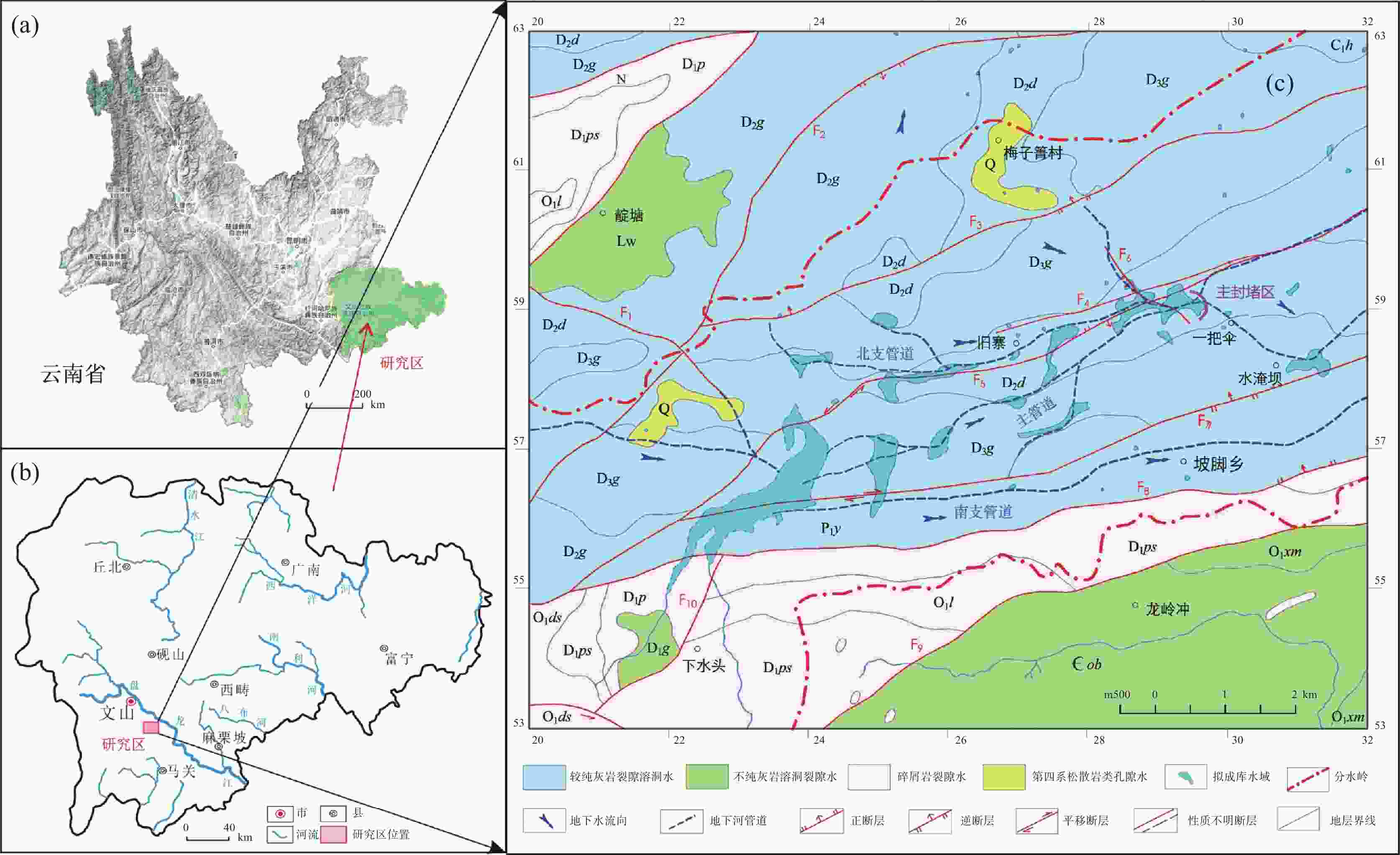
 下载:
下载:
